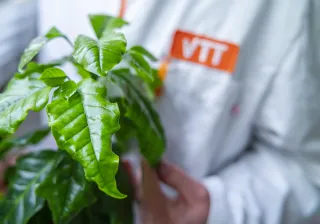Black swan, boiled frog syndrome. Familiar metaphors when we talk about phenomena such as wars, climate change and pandemics. But instead of surprising us, they could almost always be predictable. That's why we can influence what the future will look like. So says Arho Suominen, D.Sc.(Tech.), who joined VTT as Research Professor of Strategic Foresight on 2 January 2024.
“If we look through the lens of Finland, it’s in everyone's interest that we have competitive companies in the future. That's why we need strategic foresight to continuously analyse how the operating environment is changing and how we can build the most likely future for us to be most successful,” says Arho Suominen.
He points out that Finnish business is globally networked. Everyone should have some form of foresight process in place to ensure the continuity of their business and strengthen their resilience.
“Many Finnish companies and public bodies do strategic foresight, but this fails if decision-makers just file the reports away in their desks and don’t use them in decision-making. Communication is important in foresight, to understand what needs to be done this moment to prepare for the future. In companies, the owner and investors must also challenge the means by which the company prepares for the future,” says Suominen.
You don't need a crystal ball to see into the future. Usually impending changes are already known and visible, but their slow evolution makes it difficult to anticipate their impact.
“Without foresight, we’re like a frog in cold water that doesn't notice the water getting hot. We talk about black swans, even though there are often existing signs that a crisis, for example, is escalating. But we don’t react until the situation is already upon us.”
The task of actively shaping the future
At VTT, Arho Suominen's role is to lead research and act as content director, as well as to provide insight and share his experience. In his previous role at Nokia, he was responsible for improving senior management decision-making through effective analytics and trend forecasting. Kalle Kantola, Vice President, Foresight and Data Economy at VTT, appreciates Arho Suominen's very strong background and diverse expertise in foresight research and application.
“Arho's experience is an excellent fit with the hot topics in foresight research, such as the potential of data and AI in foresight and the impact of foresight. He has also been involved in bringing foresight data into decision-making, which is important because even excellent research data is not enough if it’s not utilised,” says Kantola.
VTT's strategic foresight services help decision-makers to trust in the future and make decisions to actively shape it. The services are delivered by around a hundred experienced and highly skilled professionals.
“We think about foresight in a very broad way and have, for example, a business foresight team, data team and impact professionals. Our job is to get the client's organisation to change and thereby influence its own future,” emphasises Suominen.
More data than ever is available about the world. The ways data is analysed have also drastically changed. VTT's foresight research work uses, for example, big data, machine learning, large language models, Delfoi processes and qualitative and quantitative ways of involving stakeholders. Suominen himself does a lot of natural language analysis of documents.
As a doctor of electronics, he considers VTT's absolute strength to be its technological expertise:
“We don't just talk about technology, we do it. It's really inspiring how easily I can ask another expert about the impact of a technology and what it enables. I’m currently interested in technological development and sustainability,” says Arho Suominen.





